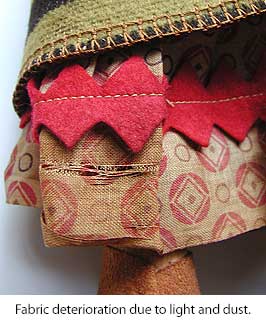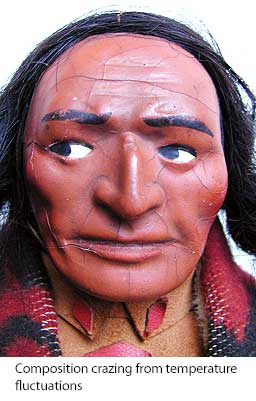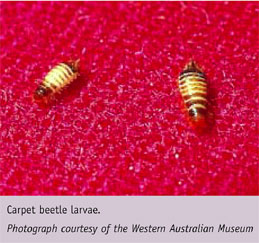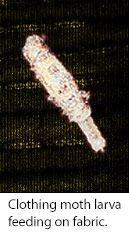|
Now that you have acquired some wonderful Skookum dolls for your collection, you might be wondering, “What is the best way to care for them?”
Skookum Indian dolls are made with almost entirely natural fibers. Human or mohair (wool) wigs, excelsior (wood) stuffing, cotton sack bodies, clothing and blankets, wooden legs, wool felt pants and trims, and leather or paper tape shoes. These natural fibers are especially susceptible to damage over time. Below are the environmental factors that most affect the long-term condition of your dolls.
Light: Both artificial and natural light cause damaging photochemical reactions in textiles and natural fibers. The result of the chemical action is fading, discoloration and a weakening of fibers. Once the process has begun it is irreversible. It is very important to keep your dolls away from sunlight, direct or indirect. Fluorescent lighting can be just as harmful as sunlight unless you have covered the fluorescent bulbs with UV filtering sleeves. Incandescent light, even in your doll cases is the best choice. Be careful not to leave the case lights on for extended periods of time as they produce heat, which can be very drying and can damage the natural fibers as well. If your doll collection must be displayed in a brightly-lit area, be sure no sunlight falls on the dolls directly as the added heat only speeds up the chemical reactions. Make an attempt to rotate the position of your dolls every few months so that some of the dolls get a rest from the light.
Temperature/Humidity: As mentioned above, heat speeds the damaging chemical reactions in natural fibers. It also causes yellowing of fabrics and drying out of mohair, human and horsehair wigs. Heat and humidity also cause expansion in composition and plastic. Colder temperatures in the winter months cause materials to contract. Combine the heat and humidity of summer with a change to cold temperatures in the winter months and the result can be badly crazed and cracked composition masks and facial paint, loose wood feet and cracking or loose leg dowels. Never store your dolls in an attic or basement where temperatures are sure to fluctuate from season to season. Along with the seasonal change in temperature there will be a change in the relative humidity. The biggest problem associated with humidity is mold and mildew. Make sure air can circulate around your dolls and never keep them enclosed or stored in an extreme environment whether it be a damp, cold basement or hot, dry attic.
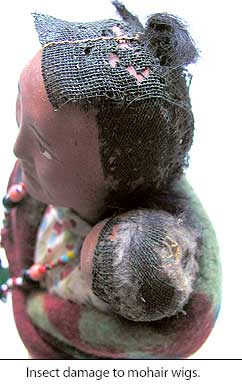 Insects: I'm sure if you have been collecting Skookum dolls for any length of time, you are already familiar with damage done to Skookums by insects. The most common insects to prey on Skookum dolls seem to be clothes moths and carpet beetles. It is important to note that it is at the larval stage in the life cycle of these insects that the damage is done. You may have noticed a small shell or casing in a doll's mohair wig that is shed by a growing carpet beetle. Or perhaps you have seen a half-inch long, slender, whitish sticky case of a clothes moth tucked into a blanket's fold? More frequently seen are the holes left behind by these hungry and pesky invaders. They especially love the wool felt of pant legs and I am sure you have seen the bare remains of a once full mohair wig on more than one Skookum head. They will also gladly devour a Skookum’s oval label to feast on the tasty glue on the underside. When you bring a new doll into your home, examine it for any signs of insects. Gently remove any casings or shells with a soft brush, preferably out doors to prevent contaminating any other dolls. I also recommend a gentle vacuuming. (See next section on dust). Should you find you have an acute infestation of insects, professional fumigation may be necessary. Cedar not only helps in the prevention of moths but it is believed to be helpful in preserving composition masks as well. Inexpensive cedar shavings sold in pet shops can be placed in doll cases or used when storing dolls to keep pests at bay. Although mothballs can be used, I find the odor too intense and I am not sure of the long-term effect of the active ingredient Naphthalene on plastic or composition. Insects: I'm sure if you have been collecting Skookum dolls for any length of time, you are already familiar with damage done to Skookums by insects. The most common insects to prey on Skookum dolls seem to be clothes moths and carpet beetles. It is important to note that it is at the larval stage in the life cycle of these insects that the damage is done. You may have noticed a small shell or casing in a doll's mohair wig that is shed by a growing carpet beetle. Or perhaps you have seen a half-inch long, slender, whitish sticky case of a clothes moth tucked into a blanket's fold? More frequently seen are the holes left behind by these hungry and pesky invaders. They especially love the wool felt of pant legs and I am sure you have seen the bare remains of a once full mohair wig on more than one Skookum head. They will also gladly devour a Skookum’s oval label to feast on the tasty glue on the underside. When you bring a new doll into your home, examine it for any signs of insects. Gently remove any casings or shells with a soft brush, preferably out doors to prevent contaminating any other dolls. I also recommend a gentle vacuuming. (See next section on dust). Should you find you have an acute infestation of insects, professional fumigation may be necessary. Cedar not only helps in the prevention of moths but it is believed to be helpful in preserving composition masks as well. Inexpensive cedar shavings sold in pet shops can be placed in doll cases or used when storing dolls to keep pests at bay. Although mothballs can be used, I find the odor too intense and I am not sure of the long-term effect of the active ingredient Naphthalene on plastic or composition.
Dust/Smoking: Although it would be ideal to have all dolls stored in display cases, it is not always possible. Some of the dolls inevitably must rest on an open shelf or tabletop. Dust left unattended invites insects, breaks down fibers, and reduces the brightness of colors. It also attracts other airborne pollutants. A light touch with a feather duster works wonders in removing particles from hair and faces as well as the clothing. For heavier dust and dirt problems a good vacuuming may be needed. I highly recommend a monthly vacuuming of your unprotected dolls. Always place a piece of old pantyhose or extra fine mesh over the vacuum's nozzle to prevent inadvertently sucking up any beads or hair ties. Be very, very gentle and always use a low power suction so that you don’t damage your doll. Don’t forget the folds of blankets where dust and insects would especially like to settle.
The tar and nicotine left behind from smoking are other damaging factors you should consider. The sticky, yellow stains from the smoke’s residues are nearly impossible to remove from dolls clothing, face and hair, not to mention how difficult it is to remove the smell. If you are a smoker, or live with one, if possible keep your Skookum dolls in a closed display case or in a room that is ”smoke-free.”
Having a Skookum doll collection is such pleasure. With a little effort we can preserve these wonderful dolls for future generations to enjoy.
Top
|

|

